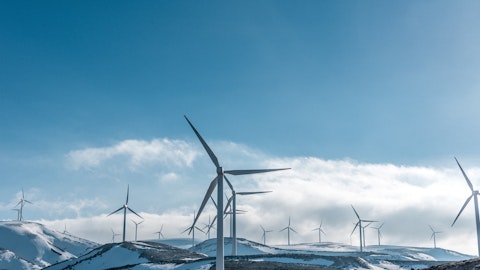Gerardo Norcia: So Sophie, I’ll say this much, certainly, any good company faced with uncertainty, any type of uncertainty, we do scenario planning. And we’re in the midst of that. I think we’re well advanced in our thinking. And once we receive a rate order, we’ll roll out our plans and our reaction. I don’t want to get ahead of ourselves at this point in time and we’ll await the order from the commission and then we’ll provide our guidance and long-term plan which I believe at this point, will all be very positive. I don’t sense at this point, that there would be a disruption in our ability to invest. I feel confident about the need to make the investment and that there’s alignment. But then again, in order to be prudent, we were also doing a lot of scenario planning to ensure that we can respond to whatever happens.
Operator: Your next question comes from the line of Travis Miller with Morningstar.
Travis Miller: You’ve answered most of my questions here. So just 2 real quick ones. In terms of the coming announcements in terms of guidance and capital investment, long-term growth, what about the dividend, the quarterly dividend announcement will that also come after the rate case and the planning?
David Ruud: Yes. Yes, that will come then. I think it may come even a little bit before that, depending on when — when that final rate case comes out.
Travis Miller: Okay. So definitely after the rate case but potentially…
David Ruud: Yes. So it’ll be in the first December yes.
Travis Miller: Okay, perfect. And then, the interveners that you mentioned that really weren’t all that keen on settling. Have they been in previous rate cases? Have they been interested in settling before? Did you know these people before and were they familiar with the rate case process?
Gerardo Norcia: I would say that the — we know them. Of course, we know them. We’ve been involved with them in many other rate cases. As we try to bring all these parties to settlement, I would say the parties that typically don’t have strong interest in the economics of the case are the ones that we had challenged bringing to the table, not all, not exclusively all but I would say most — the majority of the parties that we were not able to engage in settlement discussions probably had typically their function, their mission is not tied significantly to the economic interest of our customers.
Operator: Your next question comes from the line of Ryan Levine with Citi.
Ryan Levine: On cost cutting, were there additional tools that were decided not to use in the third quarter? Or should we think of Q3 as the MAX from a cost flex for the company?
David Ruud: Yes. We look — we’ve been looking across our company ever since the end of last year for any opportunities that we had. And we saw that we put all we had in place through the beginning of the year. You saw the $270 million of offsets that we had. So — we’ve — a lot of this plays out still through the end of the year. I mean these are annualized numbers may play out through the end of the year but it’s going to be a consistent number with what we’ve been now for cost cuts.
Ryan Levine: Okay. And then on storms, I know that’s been asked and answered. But in terms of the longer-term outlook, your neighbor utility, some studies talking about directionally 25% increase in store storms through 2050. Is there any comparable analysis that applies to your jurisdiction? Or how are you thinking about the longer term impact? And is that $55 million number appropriate? Or kind of was the growth rate that you think is appropriate to apply to?
David Ruud: Yes, we continue to look at that. We’ve seen the increasing weather patterns also and look at the increasing storm impact that has. And so we do build in some contingency beyond what’s and rates. But again, as we’ve talked about, we’re going to look at what we need the budget going forward as well as what are some of the other mechanisms we can use to manage storm going forward.
Operator: Your next question comes from the line of Gregg Orrill with UBS.
Gregg Orrill: You mentioned you’re expecting to get some cash back this year in the PSCR, can you quantify that?
David Ruud: Yes. Our under recovery last year was about $420 million. And so we’ve been recovering that throughout the year. So we’re going to get the majority of that back through in this year. So it’s a little over $380 million we’ll be getting back to this year. So that’s obviously swings the cash and FFO for us quite a bit by $800 million year-over-year.
Operator: This concludes our Q&A for today. I turn the call back over to Jerry Norcia for closing remarks.
Gerardo Norcia: Well, thank you, everyone, for joining us today. I’ll just close by saying I’m excited about the opportunities we have ahead of us, including further strengthening of our electric grid and preparing for increased demand for electrification on our system and accelerating our path to cleaner generation. We continue to be well positioned for future growth and we’ll provide additional details after our rate case wraps up. Hope everyone has a great morning and a safe day.
Operator: This concludes today’s conference call. You may now disconnect.
Follow Dte Energy Co (NYSE:DTE)
Follow Dte Energy Co (NYSE:DTE)
Receive real-time insider trading and news alerts



